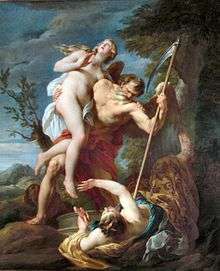François Lemoyne
| Francois Lemoyne | |
|---|---|
| Born |
1688 Paris, France |
| Died | 4 June 1737 |
| Nationality | French |
| Education | Académie de peinture et de sculpture |
| Known for | Painting |
| Movement | rococo |

François Lemoyne or François Le Moine (1688 – 4 June 1737) was a French rococo painter, born in Paris. In 1701, when he was 13 years old, he entered the Académie de peinture et de sculpture. He studied under Louis Galloche and stayed until 1713. In 1711, Lemoyne won the Prix de Rome. He was accepted as a member of the Académie in 1718 and was elected as a professor in 1733.
The duc d'Antin (Louis-Antoine de Pardaillan de Grondin) was the director of the Bâtiments du Roi and had a competition in 1727 for history painters of the Académie. Twelve large history paintings were submitted. Lemoyne had to share the first prize with his competitor Jean-François de Troy (Paris 1679 - Rome 1752).
His work and talent, notably plied in Versailles, earned him the name of the "new Le Brun". He became Premier peintre du Roi and worked with other artists of the era, such as Nonotte, Gilles Dutilleul, Charles de La Fosse and Coypel. However, the excess of work, court intrigues at Versailles, and the death of his wife drove him to madness. He committed suicide in Paris in 1737 by stabbing himself seven times, six months after finishing the ceiling painting ("L'apothéose d'Hercule") in the Salon d'Hercule in the grand appartement du roi. With his death, the fashion of large allegorical ceilings disappeared.
Works
- Louis XV donnant la Paix à l'Europe, Salon de la Paix in Versailles (1727)
- Ceiling of the Salon d'Hercule in Versailles (1736)
- Arch of the Church of Saint-Thomas-d'Aquin in Paris
- Diane chasseresse
- Les Nymphes
- Narcisse
- He also worked at Saint-Sulpice and at the Abbey of Saint-Germain-des-Prés
References
- Cours sur la peinture du XVIIIe, 2006, Université Nancy 2
- Xavier Salmon : François Lemoyne à Versailles, Gourcuff, Paris 2001, ISBN 2-909838-57-9
- Jean-Luc Bordeaux, Francois Le Moyne ( 1688-1737) and His Generations, published in 1984-1985 jointly by the Getty Trust and the Louvre Arthena. ( reviewed by the late Philip Conisbee in the Burlington Magazine in 1985.
| Wikimedia Commons has media related to François Lemoyne. |
